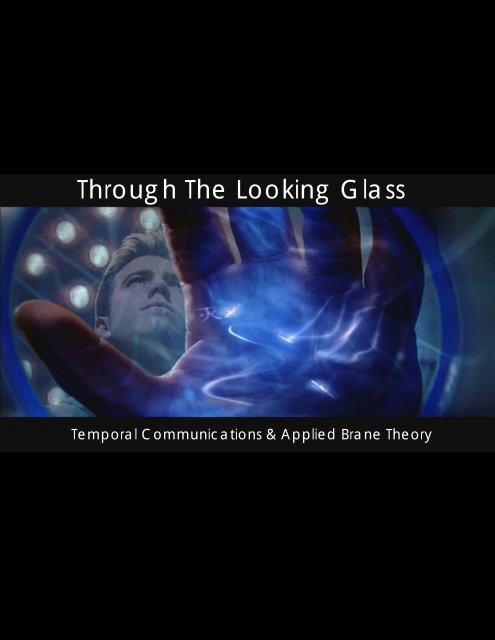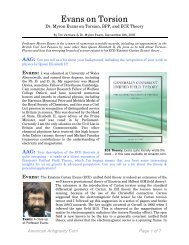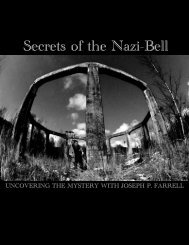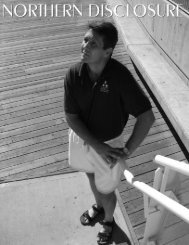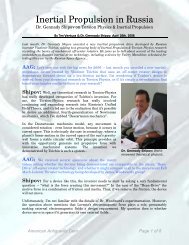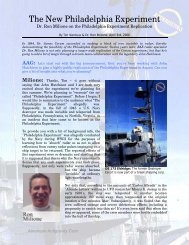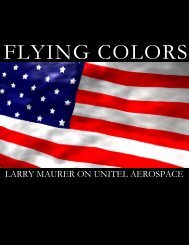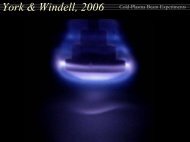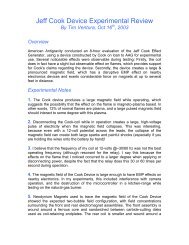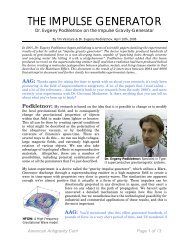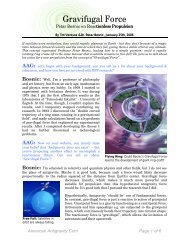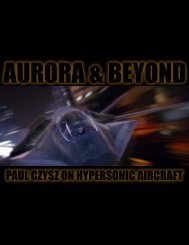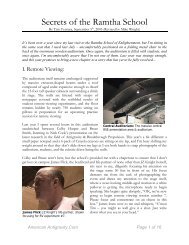Time-Travel-Intervie.. - American Antigravity
Time-Travel-Intervie.. - American Antigravity
Time-Travel-Intervie.. - American Antigravity
You also want an ePaper? Increase the reach of your titles
YUMPU automatically turns print PDFs into web optimized ePapers that Google loves.
Through The Looking Glass<br />
Temporal Communications & Applied Brane Theory<br />
<strong>American</strong> <strong>Antigravity</strong>.Com Page 1 of 9
Through the Looking Glass<br />
Temporal Communications & <strong>Time</strong>-<strong>Travel</strong> in Applied Brane Theory Physics<br />
By Tim Ventura, Heinrich Päs, Thomas Weiler, and Sandip Pakvasa, June 11th, 2006<br />
The 2003 Blockbuster movie Paycheck described a fictional device capable of sending information from<br />
the future to the past -- but if Dr's Päs, Pakvasa, and Weiler are correct, this technology may not remain<br />
fictional for long. These groundbreaking scientists join us to discuss the idea that neutrinos can jump<br />
into higher-dimensional states that allow faster than light travel to carry a signal back in time, as well<br />
as the implications of a new generation of ideas coming out of applied string & brane-theory physics...<br />
AAG: Let's start out with the inside scoop on what the buzz is all about -- a New Scientist<br />
article about your joint-paper, "Closed timelike curves in asymmetrically warped brane<br />
universes". It predicts a real time-travel effect resulting from neutrino movement in higherbrane<br />
space. Can you give us a bit of a layman's overview on exactly what you were predicting?<br />
Päs: In the New Scientist article you mentioned<br />
by Marcus Chown, we discussed the causality<br />
properties of a special kind of extra-dimensional<br />
spacetimes. In these spacetime’s the extra<br />
dimension - or "bulk" - is asymmetrically warped<br />
in such a way that the speed of light varies with its<br />
position along this extra dimension. This allows for<br />
shortcuts through the extra dimensions.<br />
Several interesting aspects of such spacetimes have<br />
been discussed before: they may help to solve the<br />
puzzle of why the universe is homogenous over<br />
distances having no causal contact in standard<br />
cosmology - and thus provide an alternative to an<br />
epoch of inflation in the early universe, as<br />
discussed by Dan Chung and Katie Freese; they<br />
might explain why the dark energy contribution to<br />
the Universe's energy budget is so small - it may<br />
actually leak into the extra dimension, as has been<br />
pointed out by Josh Erlich, Csaba Csaki and<br />
Christophe Grojean, and finally - if there are sterile<br />
neutrinos allowed to travel in these extra<br />
dimensions - it may solve an experimental anomaly<br />
Paycheck, 2003: Could sterile neutrinos<br />
make Philip K. Dick’s fictional idea a reality?<br />
observed in neutrino oscillation experiments, as has been demonstrated by us. In our recent<br />
paper we have pointed out that the effective superluminality of particles travelling in the bulk<br />
could also allow to send these particles back in time.<br />
Weiler: Of course, for the model to have validity, Nature has to oblige us with 1) extra<br />
dimensions, 2) a warped spatial metric, and 3) sterile neutrinos. Individually, each requirement<br />
is not asking too much, but taken together, we may be begging her for too much.<br />
AAG: You know, one of the compelling things about this paper is that you're doing real work<br />
in applied string & brane-theory physics, which is something that was unheard of even as<br />
recently as last year. It's been less 6 months since Dr. Lisa Randall told me that she wasn't aware<br />
<strong>American</strong> <strong>Antigravity</strong>.Com Page 2 of 9
of any applied-physics research in this area, and I've already seen a paper on the Alcubierre<br />
warp-drive by Dr. Eric Davis and your work predicting form of time-travel on a subatomic level.<br />
What does this say about progress in string & brane theory research, and do you think that we're<br />
going to see more remarkable predictions from these emerging scientific models as they become<br />
more fully developed and accepted?<br />
Pakvasa: Actually we would not say that we have made "a prediction"; rather we point out<br />
what some of the possible "applications" of the extra dimensions may be.<br />
Päs: We also should add again, that our scenario involves a lot of "ifs". What we claim is that<br />
it may be possible to send gravitons or sterile neutrinos back in time, if there is an extra<br />
dimension, if this extra dimension is asymmetrically warped, and if there are sterile neutrinos<br />
which are allowed to travel in this extra dimension.<br />
While there might be good reasons to believe in<br />
these assumptions, as they provide solutions to<br />
present problems, none of them has been proven<br />
yet. In any case - if large extra dimensions - in one<br />
form or the other - are realized in Nature, there<br />
might be interesting applications we even don't<br />
dream about yet.<br />
Weiler: We need to demonstrate a breach in<br />
the wall of the Standard Model of Particle Physics<br />
and standard General Relativity. If that happens,<br />
the flood of researchers will quickly flow through<br />
the crack to widen it. The LSND neutrino result, if<br />
validated soon by miniBooNE at Fermilab, would<br />
blow the wall of the Standard Model away.<br />
AAG: I guess the best way to qualify the concept<br />
you've developed is to say that you're making a<br />
prediction of a time-travel effect by neutrinos, but<br />
that this prediction isn't going to immediately lend<br />
itself to the classic science fiction warp-drive that<br />
can transport people and equipment, right?<br />
Dr. Heinrich Päs: Post-doctoral research<br />
associate at the University of Hawaii.<br />
Pakvasa: Again, not prediction, but the possibility of a time travel effect for sterile<br />
neutrinos. And yes, to connect the time travel of sterile neutrinos to macroscopic objects is a far<br />
cry, and although not forbidden it seems to be forbidden at any kind of practical level.<br />
Weiler: Perhaps in the distant future, we will evolve so that our consciousness resides in a<br />
ball of sterile neutrinos. Then we can teletransport ourselves. If the accelerating Universe is as it<br />
appears, we will need to do a lot of evolving just to survive the distant distant future.<br />
AAG: Let's back up a second and talk about sterile neutrino's -- if I'm interpreting this<br />
correctly, these are a form of neutrino that's not connected to the physical brane that our<br />
traditional 4 dimensions of space-time are located in, right? However, isn't what makes them<br />
truly interesting is that they can "phase in and out" of normal time-space by conversion to<br />
normal neutrino's, making them something that can be shipped back in time & captured<br />
presumably at a given location?<br />
<strong>American</strong> <strong>Antigravity</strong>.Com Page 3 of 9
Pakvasa: The sterile neutrinos are in the "bulk", that is the extra dimension as well as the<br />
brane; just like gravitons. They may mix with ordinary neutrinos, and hence ordinary neutrinos<br />
can oscillate back and forth between being ordinary and sterile. This is what makes the time<br />
travel possibility accesible to us living on the brane.<br />
Päs: In this scenario actually the usual matter is special, in that it is confined to our 4-<br />
dimensional brane. It is described by open strings ending on this brane, and thus being attached<br />
to it. It can interact gravitationally and via Higgs boson couplings to the open strings that<br />
propagate in the extra dimension. Namely the graviton and the hypothetical sterile neutrino.<br />
AAG: I think that one of the lessons that we've learned from Quantum Computers has been<br />
that while working with subatomic particles isn't as romantic as something like transporting a<br />
starship, it can still provide a powerful tool for processing information & communications. So<br />
even if a person can't use your model to travel back in time, it's possible to still play havoc with<br />
causality by sending messages to the past, right?<br />
Pakvasa: Well, in principle yes. That is why<br />
all the usual paradoxes will raise their ugly head<br />
and the question of Hawking's conjecture come up<br />
to "solve" them.<br />
Päs: It does solve the question why we didn't<br />
meet tourists from the future (they are not<br />
composed of sterile neutrinos or gravitons), but it<br />
still can jeopardize causality the way we are used to<br />
it. Quantum computing pioneer David Deutsch has<br />
actually come up with a many-world interpretation<br />
of quantum mechanics in which changing the past<br />
is possible, but consistent.<br />
Weiler: If what we are suggesting were to be<br />
true, then I would want to build a gigantic neutrino<br />
detector to look for signals from the future, the<br />
past, and maybe especially, from the bulk<br />
connected to other branes.<br />
Dr. Tom Weiler: Professor of Physics at<br />
Vanderbilt University in Nashville, Tennessee.<br />
AAG: I've read science fiction plots about time-travel devices that can only travel as far back<br />
as the initial construction or operation of the receiver -- in this case, presumably a complex<br />
neutrino detector for probably a low bandwidth data transmission system. Do you think this<br />
might be similar?<br />
Päs: This is a typical constraint on time travel scenarios - you can go back in time only as<br />
long as your path exists. In our case the extra dimension might exist forever, so signals might<br />
influence physics in the very far past.<br />
For controlled signal exchange, however, the neutrino detector is necessary and you are right<br />
that this constrains the earliest possible neutrino detection. There are other constraints as well,<br />
depending on how strongly the extra dimension is warped, and how large the relative speed of<br />
the neutrino detector and source is.<br />
<strong>American</strong> <strong>Antigravity</strong>.Com Page 4 of 9
AAG: On a more philosophical note, while numerous authors have written about time-travel<br />
& temporal communications technologies, one of the most interesting plots was in Arthur C.<br />
Clarke's "The Light of Other Days", in which he suggests that the ability to truly communicate<br />
across time might effectively end time itself from the observer's perspective. In his case, he was<br />
postulating a wormhole-camera that could truly see the past, basically making all of human<br />
history converge to a degree into the present, but your technology is also similar to Philip K.<br />
Dick's device portrayed in the movie "Paycheck" -- making it potentially even more powerful.<br />
Any thoughts on what this would do to time from a human social perspective?<br />
Pakvasa: As you point out, many possible<br />
implications of such devices have already been<br />
thought about in science fiction and in physics<br />
literature. Since our device is a time travel device,<br />
many of these would apply to it as well.<br />
Päs: What exactly it would mean if we could<br />
travel back in time would depend on whether it<br />
would be possible to change the past and how<br />
physics will be consistent under these<br />
circumstances. In any case it might show that our<br />
present daily-life understanding about causality<br />
and time has to be dismissed.<br />
Weiler: I like the idea of causality-violation<br />
destroying our concept of time. People have looked<br />
at two-time theories and found them inconsistent.<br />
How about a no-time theory? To quote the man<br />
himself, Einstein: "<strong>Time</strong> and Space are modes in<br />
which we think, not conditions in which we live."<br />
Dr. Sandip Pakvasa: Professor of Physics<br />
at the University of Hawaii.<br />
AAG: Since I've mentioned wormholes, I should ask about exotic matter: this is a subject<br />
that's come up in the context of traversing or sending data through wormholes, and in the<br />
papers that I've seen presented in the past, the requirement comes out of a necessity for negative<br />
mass or an equivalent amount of negative energy. However, you're postulating that the exotic<br />
matter required for your experiment already exists, right -- in higher-dimensional brane space?<br />
Pakvasa: Yes, the point is that in our scenario, the negative energy density is needed but<br />
only in the extra dimension(bulk), but not in the brane . The fact that we do not need negative<br />
energy density in the ordinary space-time is an advantage and this may be a good thing.<br />
Päs: A problem with exotic matter is not only how to produce it, but that quantum<br />
fluctuations to its energy may actually explode and destroy the time machine.<br />
This behavior has been predicted for several classical proposals of time machines. While we<br />
didn't perform this calculation, the result may strongly depend on the number of dimensions,<br />
and our proposal may be stable against such quantum effects.<br />
Weiler: An interesting feature that we did show is that on our brane, we can have positive<br />
energy but at the expense of having negative pressure. But this is exactly what one gets in a<br />
cosmology dominated by a cosmological constant, which is in fact the very one that describes<br />
our accelerating Universe.<br />
<strong>American</strong> <strong>Antigravity</strong>.Com Page 5 of 9
AAG: Now one of the notions that surprised me was the idea of a "bulk", which I guess would<br />
be all of the extra-dimensions higher than the 4 traditional dimensions we see in normal timespace,<br />
right? In your model, are these dimensions curled up within the planck-distance as string<br />
theory has postulated in the past, or are they pervasive through the entirety of the universe?<br />
Maybe that's a trick question -- I've also heard that since these are higher-dimensions, then can<br />
be like micro-wormholes: both curled up into the planck-distance as well as being able to<br />
connect any two points in the universe.<br />
How do you visualize these dimensions in<br />
your model?<br />
Pakvasa: The scenario we used<br />
corresponds to the so-called "large extradimensions",<br />
in which the extra<br />
dimension is not so small.<br />
Päs: If the extra dimensions were<br />
small, particles could not penetrate very<br />
far. The model is similar to the warped<br />
scenarios of Lisa Randall and Raman<br />
Sundrum. It connects different points in<br />
our universe due to the warping: the<br />
measure of space shrinks in the extra<br />
dimension, while the measure of time<br />
stays constant, so that in the same time<br />
interval you can advance more space<br />
intervals. This produces the<br />
superluminality required for time travel.<br />
Brane Bulk: If neutrinos jump to higher-dimensional<br />
spacetimes, they may travel backwards in time.<br />
AAG: How does the notion of a "bulk" of hidden & disconnected dimensions above the<br />
normal 4 relate to Kaluza-Klein theory, in which a higher-dimensional time-space is inherently<br />
connected to our brane by deriving out into Maxwell's traditional equations for<br />
electromagnetism?<br />
Pakvasa: The modern models of extra dimensions are inspired by the original ideas of<br />
Kaluza and Klein, but are inherently different. One is not trying to derive both gravity and<br />
electrodynamics from a single metric as they did. But they are now immortalised because the<br />
excitations in extra dimensions are called KK(for Kaluza-Klein).<br />
Weiler: Yes, the model we explored has all quanta but gravitons and sterile neutrinos<br />
confined to the brain. This is quite different from Kaluza's and Klein's original work.<br />
AAG: Now in terms of this extra-dimensional bulk, my understanding is that many of these<br />
extra-dimensions derive out of equations that don't fully explain what the dimensions actually<br />
are or contain. However, Kaluza-Klein hints that perhaps they may contain or may derive into<br />
new forces that we haven't encountered yet -- any thoughts on the possibility of completely new<br />
forces or phenomenon arising from the bulk that we haven't yet seen or even fully predicted?<br />
<strong>American</strong> <strong>Antigravity</strong>.Com Page 6 of 9
Päs: Several new phenomena have been discussed by particle physicists and cosmologists.<br />
One prominent example is the Kaluza-Klein excitations of particles travelling in the bulk, which<br />
Sandip mentioned already. Another possibility is that gravity becomes suddenly strong as<br />
energy increases, and black holes could be produced in particle collisions. Such effects may be<br />
discovered by a future particle collider such as the<br />
LHC, which is under construction at CERN in<br />
Geneva.<br />
Weiler: The bulk is used to explain not a new<br />
force, but rather an old force, gravity. The bulk<br />
explains why gravity is so inherently weak on the<br />
scale of particle physics. The sterile neutrino<br />
cannot mediate a new force, because it has the<br />
wrong spin (a long story). But if low mass spin zero<br />
or spin one "gauge singlet" particles are ever<br />
discovered, we could feel their long-range bulk<br />
force. The fact that we haven't felt them yet<br />
probably means they do not exist, or we do not<br />
have the right detectors for them.<br />
AAG: Now when Marcus Chown wrote about<br />
your paper in New Scientist's "Head 'em off at the<br />
past", he invoked Hawking's "Chronology<br />
Protection Mechanism" as a potential mystery-limit<br />
Precognition: Will foreknowledge of future<br />
events violate the principle of causality?<br />
preventing communication into the past, but that seems to be at odds with the Quantum<br />
Computing crowd's conviction that the "Many Worlds" interpretation of QM allows what we<br />
might perceive to be all sorts of violations of causality - including proven computational<br />
methods. Any worries about paradoxes?<br />
Pakvasa: The chronology protection conjecture of Hawking is meant to just prevent all the<br />
paradoxical effects in presence of time machines, such as the grandmother paradox and selfconsistency<br />
paradox etc. It has nothing to do with the Many worlds interpretation of QM.<br />
Weiler: "Paradoxes" are never a worry; they are a signpost to better logic.<br />
AAG: One area that I'm a little blurry on is whether the neutrino's travel instantaneously to a<br />
point in the past like we'd envision quantum-tunnelling or wormhole travel, or if they instead<br />
travel at a normal sublight-speed backwards in time. Is this splitting hairs, as to the observer it<br />
would have same effective outcome -- they appear out of nowhere and may contain useful<br />
information?<br />
Pakvasa: The specific example we constructed corresponds to the following effect. We<br />
send a pulsed beam of neutrinos into the earth, let's say at time t. After conversion to steriles,<br />
reconversion to ordinary neutrinos, etc, we can bring some neutrinos back to the starting point<br />
arriving at time t'. If t' is earlier than t, we have a time machine and have travelled to the past.<br />
Päs: In their own frame the particles always travel forward in time. But for an observer - or a<br />
neutrino detector - travelling with a relative speed as compared to the frame where the particle<br />
was sent off - the particle travels back in time.<br />
<strong>American</strong> <strong>Antigravity</strong>.Com Page 7 of 9
Weiler: A common source of "paradox" is taking time as a physical entity common to all<br />
observers. Don't do that.<br />
AAG: As a follow-on to the idea of travel-velocity, hypothetically speaking, how would you<br />
select a destination-time to send the neutrinos to? Would it involve calculating a specific<br />
distance of travel versus a negative progression of time, or is there some potential to tunnel<br />
these neutrinos as far back in time as required?<br />
Pakvasa: Once the concept is established, the precise time difference, space point etc are<br />
all practical technical details....<br />
Päs: The destination will depend on the<br />
properties of the extra dimension - the amount of<br />
warping - and the relative speed of neutrino source<br />
and detector.<br />
Weiler: This is my favorite question in the lot.<br />
A related question is where in space will timetranslated<br />
quantum arrive at? According to the<br />
geometric theory of General Relativity, all quanta<br />
should follow geodesics. Take a path from A to B<br />
which is a geodesic for particles stuck to the brane.<br />
Now take a sterile neutrino at A and send it on its<br />
geodesic into the bulk. It is not clear to me that it<br />
will ever show up at B.<br />
What we showed is that there exists a shorter path<br />
through the bulk from A to B for the sterile, but<br />
there may be even shorter paths for it to go<br />
elsewhere. Some real CTC-engineering will be<br />
needed to make these little critters do what we<br />
want them to, like come back home to us, and of<br />
course, arrive at an earlier time.<br />
Neutrino Detector: Could a detector like<br />
Kamiokande array in Japan pick up a signal?<br />
The same could be said for the travel itinerary of gravity quanta (waves). I suppose a preferred<br />
geodesic taking gravity waves off the brane could prove problematic for experiments like LIGO<br />
and LISA which are proposed to receive gravity waves. I need to think about this more. We all<br />
need to think about these issues more.<br />
AAG: The New Scientist article hinted that we may see additional support for your theory<br />
from the MiniBoone neutrino experiment at Fermilab, which may confirm the existence of<br />
sterile neutrinos when it goes online later this year. Any thoughts on what this experiment may<br />
tell us, and if it gives us a positive answer, have you considered how to potentially send a signal<br />
to it in the future that might be deciphered when it begins collecting data?<br />
Pakvasa: The Mini-Boone experiment at FermiLAb is taking data now to check whether<br />
the effect(called LSND) seen 10 years ago in an earlier experiment at Los Alamos, is real. If yes,<br />
then that would be the first confirmed evidence that sterile neutrinos do exist and that they mix<br />
with ordinary neutrinos. So if this is confirmed, then our speculations about sterile neutrinos are<br />
at least about real objects!<br />
<strong>American</strong> <strong>Antigravity</strong>.Com Page 8 of 9
Päs: Let me add that they even are able to confirm that sterile neutrinos take shortcuts in<br />
extra dimensions. Whether these extra dimensions are asymmetrically warped - and whether<br />
sterile neutrinos can be sent back in time, is a different question.<br />
AAG: As we discussed before the interview, Marcus Chown is really an excellent sciencewriter,<br />
and his writeup on your paper made the front cover of the prestigious New Scientist<br />
Magazine, which really is quite an achievement. How does it feel to get such positive public<br />
feedback for your research, and what kind of feedback have you been getting from both the<br />
general public and the scientific community?<br />
Pakvasa: Wonderful!<br />
Weiler: I've received two handwritten letters<br />
of support from the UK. One from a retired GR<br />
practitioner, and the other from a thirteen year old<br />
schoolgirl who wants to write a SciFi novel about<br />
time travel. New Scientist does have a wide<br />
readership!<br />
AAG: I'd like to close with sincere thanks for<br />
launching this tremendous work in applied string &<br />
brane physics, as well as ask about your future<br />
plans. Any thoughts about pursuing other far-out<br />
concepts in breakthrough propulsion or<br />
communications technologies for the future?<br />
The Future Beckons: The next step for this<br />
team is engineering an experimental test.<br />
Pakvasa: We would like to finish writing up our paper in which we discuss engineering<br />
aspects of a time machine based on our proposal in the first paper.<br />
Päs: Besides this we are all involved in more conventional research, like figuring out how<br />
neutrinos acquire their tiny masses or what's the origin of highest energy cosmic rays, building<br />
models for particle physics beyond the Standard Model, as well as quark physics.<br />
Weiler: I am involved in rather exciting topics in astrophysics. I am especially intrigued by<br />
the energetics and information content of black holes. And I suspect there is much to be learned<br />
about information and communication within the single biological cell. However, at 57 yrs, I<br />
begin to empathize with Yogi Berra when he said "Most of my future is behind me." It will take<br />
more than twenty more years to realize big advances.<br />
Dr. Heinrich Pas is a post-doctoral research associate, and Dr. Sandip Pakvasa is a professor of<br />
physics – both are at the University of Hawaii at Manoa. Dr. Tom Weiler is a professor of physics at<br />
Vanderbilt University in Nashville, Tennessee. For more information, read “Closed timelike curves<br />
in asymmetrically warped brane universes” or New Scientist’s “Head ‘em off at the Past” .<br />
Movie stills © 2003 Paramount Pictures, Inc, used with permission.<br />
<strong>American</strong> <strong>Antigravity</strong>.Com Page 9 of 9


